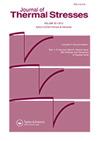姜黄根际不同假单胞菌的分离及表型微阵列分析。
IF 2.6
3区 工程技术
Q2 MECHANICS
引用次数: 0
摘要
本研究从姜黄根际土壤中分离到不同的假单胞菌菌株,并通过16S rRNA基因测序分析,根据形态、生化和分子特征对其进行鉴定和鉴定。鉴定的菌株属于假单胞菌属,即假单胞菌属CL10、假单胞菌属CL11和荧光假单胞菌属CLI4。然而,在植物生长促进性状分析中,分离菌株的IAA产量、铁载体产量和磷酸三钙增溶作用均呈阳性。进一步利用表型微阵列(PM)技术评估分离菌株的抗生素和化学敏感性。所有根细菌菌株对抗生素有耐药性,包括青霉素、奥西林、万古霉素、新生物霉素、螺旋霉素和利福平,以及5-7二氯-8-羟基喹啉、5-7二氯-8-羟基喹啉、多酚溴化物和3-5二甲氧基苯甲醇。然而,经过进一步的详细研究,假单胞菌sp. CL10对13种抗生素耐药,CL11对14种耐药,CL14对17种抗生素和化学类耐药。研究结果表明,其中部分菌株可作为促进植物生长和健康的生物接种菌。本文章由计算机程序翻译,如有差异,请以英文原文为准。
Isolation and Phenotypic Microarray Profiling of Different Pseudomonas Strains Isolated from the Rhizosphere of Curcuma longa L.
In the present study, different Pseudomonas strains were isolated from the rhizospheric soil of Curcuma longa (turmeric) and further identified and characterized based on morphological, biochemical, and molecular characteristics through the 16S rRNA gene sequencing analysis. The identified bacterial strains belong to the Pseudomonas genus viz. Pseudomonas sp. CL10, Pseudomonas sp. CL11, and P. fluorescence CLI4. However, the isolated strains tested positive for IAA production, siderophore production, and the solubilization of tricalcium phosphate during plant growth promoting traits analysis. Further phenotype microArray (PM) technology was used to evaluate the antibiotic and chemical sensitivity of the isolated bacterial strains. The antibiotics phleomycin, oxacillin, vancomycin, novobiocin, spiramycin, and rifampicin, as well as chemicals like, 5-7 dichloro-8-hydroxy quanaldine, 5-7 dichloro-8-hydroxyquinoline, domophenbrobide, and 3-5 dimethoxy benzyl alcohol, showed resistance in all the rhizobacterial strains. However, upon further detailed study, Pseudomonas sp. CL10 exhibited resistance to thirteen antibiotics, CL11 to fourteen, and CL14 showed resistance against seventeen antibiotics and chemical classes. The results of the study indicate that some of these strains can be used as bioinoculum to enhance the plant growth and health.
求助全文
通过发布文献求助,成功后即可免费获取论文全文。
去求助
来源期刊

Journal of Thermal Stresses
工程技术-力学
CiteScore
5.20
自引率
7.10%
发文量
58
审稿时长
3 months
期刊介绍:
The first international journal devoted exclusively to the subject, Journal of Thermal Stresses publishes refereed articles on the theoretical and industrial applications of thermal stresses. Intended as a forum for those engaged in analytic as well as experimental research, this monthly journal includes papers on mathematical and practical applications. Emphasis is placed on new developments in thermoelasticity, thermoplasticity, and theory and applications of thermal stresses. Papers on experimental methods and on numerical methods, including finite element methods, are also published.
 求助内容:
求助内容: 应助结果提醒方式:
应助结果提醒方式:


